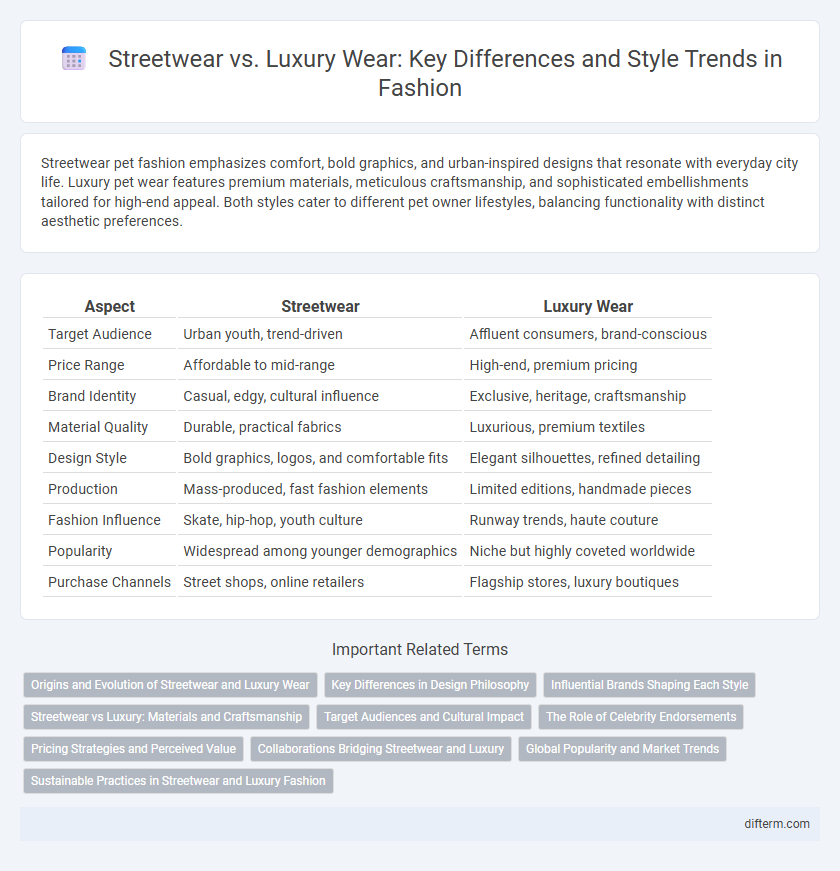Streetwear pet fashion emphasizes comfort, bold graphics, and urban-inspired designs that resonate with everyday city life. Luxury pet wear features premium materials, meticulous craftsmanship, and sophisticated embellishments tailored for high-end appeal. Both styles cater to different pet owner lifestyles, balancing functionality with distinct aesthetic preferences.
Table of Comparison
| Aspect | Streetwear | Luxury Wear |
|---|---|---|
| Target Audience | Urban youth, trend-driven | Affluent consumers, brand-conscious |
| Price Range | Affordable to mid-range | High-end, premium pricing |
| Brand Identity | Casual, edgy, cultural influence | Exclusive, heritage, craftsmanship |
| Material Quality | Durable, practical fabrics | Luxurious, premium textiles |
| Design Style | Bold graphics, logos, and comfortable fits | Elegant silhouettes, refined detailing |
| Production | Mass-produced, fast fashion elements | Limited editions, handmade pieces |
| Fashion Influence | Skate, hip-hop, youth culture | Runway trends, haute couture |
| Popularity | Widespread among younger demographics | Niche but highly coveted worldwide |
| Purchase Channels | Street shops, online retailers | Flagship stores, luxury boutiques |
Origins and Evolution of Streetwear and Luxury Wear
Streetwear originated in the late 1970s and early 1980s from subcultures like skateboarding and hip-hop in urban centers such as New York and Los Angeles, evolving through brands like Supreme and Stussy that blend casual comfort with bold graphic elements. Luxury wear traces its roots to European couture houses like Chanel, Dior, and Gucci, emphasizing craftsmanship, exclusivity, and timeless design, with evolution driven by iconic designers and high-end fashion shows. Both styles reflect cultural values and social identities, but streetwear champions accessibility and street culture, while luxury wear focuses on prestige and artisanal heritage.
Key Differences in Design Philosophy
Streetwear emphasizes comfort, practicality, and cultural expression, often featuring bold graphics, oversized silhouettes, and casual fabrics like cotton and denim. Luxury wear prioritizes craftsmanship, exclusivity, and high-quality materials such as silk, cashmere, and fine leather, with intricate detailing and tailored fits. The design philosophy of streetwear revolves around accessibility and urban lifestyle influences, while luxury wear centers on timeless elegance and premium aesthetics.
Influential Brands Shaping Each Style
Supreme and Off-White dominate the streetwear scene with bold logos and urban-inspired designs that resonate with younger audiences. In contrast, luxury brands like Gucci and Louis Vuitton showcase refined craftsmanship and timeless elegance, attracting affluent consumers seeking exclusivity. The distinct influence of these brands shapes fashion trends and consumer perceptions in their respective markets.
Streetwear vs Luxury: Materials and Craftsmanship
Streetwear emphasizes comfort and functionality with materials like cotton, denim, and synthetic blends engineered for durability and everyday wear. Luxury wear prioritizes high-quality fabrics such as silk, cashmere, and fine leather, paired with meticulous craftsmanship including hand-stitching and bespoke tailoring. The distinction lies in streetwear's focus on mass appeal and practicality, contrasted with luxury garments that highlight exclusivity and artisanal detail.
Target Audiences and Cultural Impact
Streetwear primarily targets younger, urban consumers who value self-expression, authenticity, and affordable trends influenced by hip-hop, skate, and youth culture. Luxury wear appeals to affluent, style-conscious individuals seeking exclusivity, craftsmanship, and status symbols rooted in heritage fashion houses. The cultural impact of streetwear lies in its democratization of fashion and influence on mainstream trends, while luxury wear reinforces socioeconomic distinctions and perpetuates aspirational lifestyles.
The Role of Celebrity Endorsements
Celebrity endorsements play a pivotal role in shaping consumer perceptions and driving demand in both streetwear and luxury wear markets. High-profile collaborations between celebrities and brands like Nike or Supreme elevate streetwear's cultural relevance, while luxury houses such as Gucci and Louis Vuitton leverage star power to reinforce exclusivity and prestige. The fusion of celebrity influence and brand identity significantly enhances market visibility and accelerates fashion trends across diverse demographics.
Pricing Strategies and Perceived Value
Streetwear brands often implement competitive pricing strategies that emphasize accessibility and trend-driven appeal, leveraging limited drops and collaborations to enhance perceived exclusivity. Luxury wear adopts a premium pricing model anchored in heritage, craftsmanship, and brand prestige, which cultivates a high perceived value associated with status and quality. The contrasting approaches reflect how streetwear balances affordability with scarcity, while luxury wear relies on enduring brand equity and superior materials to justify its elevated price points.
Collaborations Bridging Streetwear and Luxury
Collaborations between streetwear brands like Supreme and luxury houses such as Louis Vuitton have redefined modern fashion by merging urban culture with high-end craftsmanship. These partnerships leverage exclusive drops and limited editions to create highly sought-after collections that blur traditional fashion boundaries. By combining streetwear's edgy aesthetics with luxury's heritage and quality, these collaborations drive increased brand visibility and appeal to diverse consumer bases.
Global Popularity and Market Trends
Streetwear dominates global popularity with a youthful consumer base and rapid growth driven by social media influence and sneaker culture, capturing significant market share in regions like North America and Asia. Luxury wear maintains its status through exclusivity, heritage brands, and high price points, appealing to affluent consumers in Europe and emerging markets such as China. Market trends indicate a blending of styles, with luxury brands incorporating streetwear elements to attract younger demographics and streetwear labels collaborating with high-end designers to expand their global reach.
Sustainable Practices in Streetwear and Luxury Fashion
Streetwear brands increasingly integrate sustainable practices such as upcycling, organic cotton usage, and transparent supply chains to appeal to eco-conscious consumers. Luxury fashion houses invest heavily in sustainable sourcing, including responsibly harvested materials and carbon-neutral production processes, aiming to balance exclusivity with environmental responsibility. Both sectors prioritize circular economy models, with collaborations on resale platforms and garment recycling initiatives enhancing sustainability efforts.
Streetwear vs luxury wear Infographic

 difterm.com
difterm.com